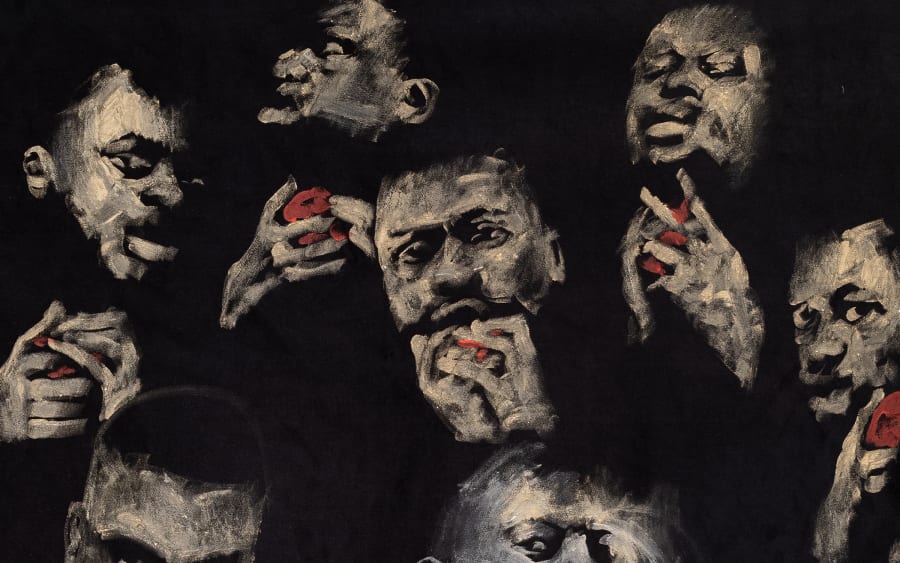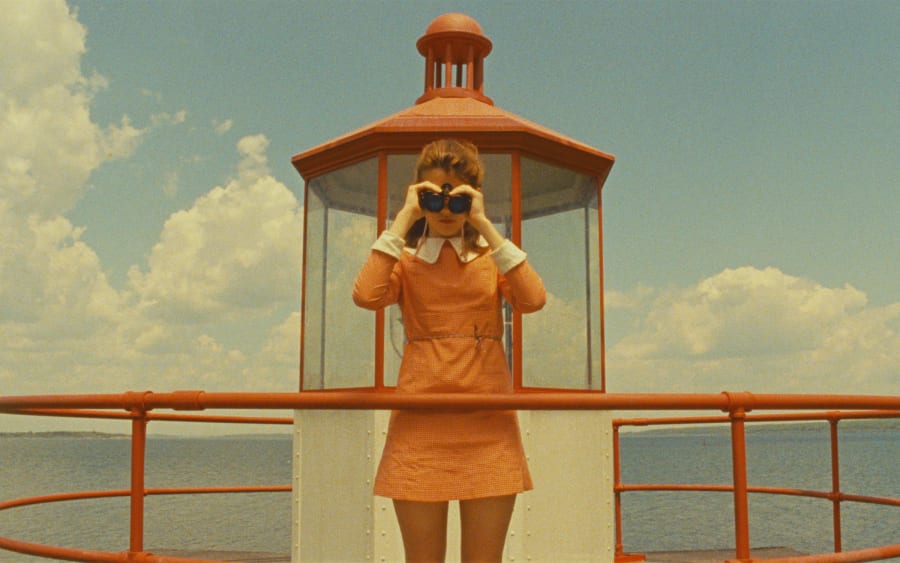The high, vaulted hall of Berlin’s Hamburger Bahnhof currently houses a scene that, while replete with instinctively familiar motifs, is a challenge to place. Along one of the former train shed’s flanking colonnades the archways have been filled with welded-together iron sheets, onto which fossil-like sandstone reliefs have been mounted. Embedded within these gnarled forms are fangs of frosted glass and blobby panels of hyperrealist embroidery. Through the center of the cavernous space, hulking sculptures made from flax fibers dangle from the ceiling’s iron girders, their disheveled tendrils slumping along a paved concrete floor towards bare squares that brim with rich loam. From a stack of speakers in their midst, a soundtrack of dirge-like chants, tolling church bells, and woodwind trills echoes; frenzied pants, howls, and growls ricochet about the room.
‘embrace’ is the Czech artist Klára Hosnedlová’s most expansive installation to date, both in terms of physical scale and conceptual scope. The show inaugurates the Chanel Commission at Hamburger Bahnhof – an annual initiative supported by the Chanel Culture Fund that will allow artists to realize large-scale projects in the museum’s historic hall. In the context of Hosnedlová’s career, though, ‘embrace’ is anything but unfamiliar. After all, the artist has long presented her practice as a material intertext, with each immersive installation becoming fertile ground for the generation of the next.
In her previous institutional shows – such as ‘To Infinity’ (2023) at Kestner Gesellschaft in Hanover and ‘GROWTH’ (2024) at Kunsthalle Basel – the mostly Berlin-based artist has proven her knack for building transportive, site-specific environments that hybridize vernaculars of architecture, object design, sculpture, photography, fashion, textile, and performance, with these layered infrastructures offering ample frameworks for her rhizome of references. To cite a few recurring ones: Czech folklore; the shifting political climates and borders of Central Eastern Europe; the functionalist architecture of Adolf Loos; Czechoslovak New Wave film.
Rather than riff on these themes directly, in Hosnedlová’s purpose-built environments, familiar tones, textures, historical contexts, and emotional timbres are abstracted. In these eerie, cinematic contexts, observers are invited to draw conclusions through a lens of personal affect, but the possibility of objective resolution is ultimately precluded.
While preparing for my conversation with the artist, I note down some of the conclusions that recur in writing about her practice – discussions surrounding the utopian, dystopian, post-anthropocentric, post-apocalyptic, alien logics that allegedly underpin her work. It’s easy enough to see how they could be drawn, but for Hosnedlová, ‘it’s quite funny,’ she says, giggling warmly. ‘This sense of the work having a “post-apocalyptic” sensibility has never been a consideration for me. And at the same time I’ve never really thought about whether it should feel “utopian” or not – or what the feeling you glean from the work “should” be, in fact. I’ve always just tried to ensure that, from my side, the work is honest.’
Hosnedlová isn’t hostile to such interpretations – rather, she revels in the poetry of the unresolved complexities and contradictions that make life what it is. I’m inclined to think that this sensibility is rooted in her upbringing in Uherské Hradiště, a town in the historic Czech region of Moravia, close to the modern-day Austrian and Slovakian borders. According to the artist, it’s a place defined by four things: folklore, viticulture, nature, and hard industry. ‘The natural landscapes are incredible, which has always been super-inspiring for me. But on the other hand, it is very hard to live here,’ she says with a sigh, speaking over Zoom from an airy apartment in her hometown. ‘There are so many factories – incredibly harsh, ugly concrete buildings – where most of my family members worked, actually. They’re the kind of places where people will toil from dawn all the way into the night, all for a very minimal wage.’
The scene that Hosnedlová sets is a consequence of particular socio-historic and political conditions – namely the rapid industrialization of Czechoslovakia, as it was then, in the 1950s and 1960s, while under Soviet influence. This context, and its generational repercussions, form the bedrock of Hosnedlová’s practice, with the tension etched into her native landscape – ‘between romance and melancholy,’ she says – serving as a fil rouge that runs through it.
In ‘embrace’, the scraggly, tentacled tapestries suspended throughout the space challenge the ‘vastness of the hall, and also its intensely masculine energy,’ creating pockets of quiet interiority within it. Woven from raw linen and hemp in collaboration with Bohemian tapestry artisans in a vaulted wooden barn close to Prague, each sculpture – some reaching 9 meters in height – has been hand-dyed by Hosnedlová in mottled earthen hues, their shaggy textures and grassy reek evoking ancient moss or matted sheep’s wool. Despite their seeming heft, Hosnedlová is quick to highlight their fragility – ‘If there were a fire, they’d go up like that,’ she says with a snap of her fingers.
Fire, incidentally, is a motif that recurs across ‘embrace’ – though thankfully not as naked flame. Rather, disembodied hands holding burning twigs to butterfly wings, or disposable lighters up to sweat-slicked torsos, figure across the exhibition’s aforementioned embroideries. Executed by hand in cotton thread on canvas, these works are, in fact, a crucial feature of the origin story of Hosnedlová’s installation practice, which was gradually elaborated as a means of ‘creating a world’ around the hand-crafted tableaux.
Hosnedlová started using this photorealist technique while studying at Prague’s Academy of Arts. ‘All of the studios there were run by men,’ she recalls, ‘and I was in the painting studio, which, granted, was a bit more open. The head of the studio did these huge, very abstract paintings, which informed how he taught. But I would always feel such intense pressure standing before a huge canvas.’
Hand embroidery quickly became Hosnedlová’s antidote to this pressure, but ‘no one in the faculty was working with textiles, and embroidery in particular was seen as a domestic hobby,’ an interpretation anchored in the parochial gendering of craft-based practices. She, however, was undeterred. ‘If I was going to be an artist my entire life, I’d have to enjoy the process at least,’ she quips, ‘so I started to work with the fibers as I would with paints,’ intuitively building tones and textures in layered cotton thread. Beyond their invocation of notions of quaint domesticity and folkloric craft, these embroidered fragments also serve as documents of a crucial, yet ostensibly absent component of Hosnedlová’s world-building: performance.
Ahead of the opening of each of her shows, the artist invites a group of amateur performers to exist within the exhibition, documenting their interactions as source material for future work. While these activations are never open to the public, they’re nevertheless key nodes that network Hosnedlová’s practice across time and place.
Embroidered fragments of previous performances and found (or lost?) objects become vestiges of an ostensibly raptured humanity. The stack of speakers nestled amid the tapestries, for example – the source of the melancholic arrangement by the Berlin-based composer Billy Bultheel. Salvaged from a techno club in the German capital, and scuffed with muddy footprints, they imply a visceral sense of place and action but stop short of confessing it.
The cumulative effect of Hosnedlová’s artistic methodology is, ultimately, a suspension of reality – or, perhaps, a calling into question of the means and strategies by which realities are constructed. In essence, the artist actively engages observers in an archaeological task, compelling them to piece together meaning from what’s left behind. But this in itself is a canny trick. There is, after all, no puzzle to be ‘solved,’ with Hosnedlová exposing the very act of ‘solving’ as rooted in conjecture, aimed at glossing over the mercurial complexities at hand. Rather than offer a definitive treatise on how the world ‘should’ be, or what the world ‘will’ become, she reveals the shaky foundations on which such premises stand.
Though Hosnedlová’s vantage point is particular, her environments become prisms for broader reflections on the frazzled contours of human history, dense palimpsests that chart the messy, turbulent, but at times sublimely beautiful consequences of our actions on – and interactions with – the world around us.
‘Klára Hosnedlová. embrace’, will be on view at Hamburger Bahnhof – Nationalgalerie der Gegenwart in Berlin from May 1 through October 26, 2025.
Mahoro Seward is a London-based writer and editor, working between fine art, fashion, and pop culture. They are currently fashion features editor at British Vogue, previously holding the same title at i-D, and have contributed to titles including Wallpaper*, Frieze, Crosscurrent, and Vogue Business.
Klára Hosnedlová is represented by White Cube (London, Hong Kong, New York, Paris, Seoul), Kraupa-Tuskany Zeidler (Berlin, Munich), and hunt kastner (Prague).
Caption for full-bleed image: Klára Hosnedlová by Vitali Gelwich.
Published on April 30, 2025.


